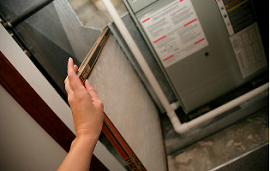After the hot summer weather, many appreciate the changing seasons and the crisp, cool air of fall. While it is sensible to start pulling your sweaters out of storage and wearing warm layers, some homeowners are tempted to maximize energy savings by not firing up their furnace until the last possible minute. Although you can save energy when the weather is not quite cold enough for heating, it is important that you test your system early. Issues can develop over the summer, and you won’t want to wait until a really cold day to find out if you have a problem.
Before you turn on your furnace after months of not being used, you should check the area around your furnace for any possibly flammable materials. Over the summer months, when the furnace is not in use, it is easy to use the area for storage, and some of these items could be a fire hazard.
You will also need to open up a few windows around your home as the first heating cycle could create an unpleasant odor. This foul smell is usually caused by lint and dust settling on the heating elements, so it is usually harmless. When the furnace is fired up, these particles quickly burn, but you won’t want your house smelling of burnt matter.
When your furnace kicks on, you should let it run for a minimum of ten minutes. This will allow any initial burning smell to dissipate. If any odor lingers, it could be an indication of a problem, and you should shut down and call for a service. While the furnace is running, listen out for any unusual sounds that could also indicate a potential issue.
Maintenance:
When you’re testing your furnace at the start of the cooler weather, it is the ideal time for a little maintenance. You should start with your filter, which needs to be changed approximately every 30 days.
You should also ensure that your thermostat is operating correctly, accurately detecting temperatures to control your furnace. You should set the thermostat to the always-on fan setting to ensure that it is properly working. It is also a good time to update your schedule on your programmable thermostat.
Finally, test the batteries in your carbon monoxide and smoke detectors, changing them if needed. This is a vital part of testing your furnace, as a malfunction could cause a household fire or release carbon monoxide into your home. If your detectors have expired, it is time to replace them before heating is being used continually.
It is tempting to keep your heating switched off for as long as possible, to save energy after running your air conditioner all summer. Unfortunately, delaying testing your furnace means that you cut down on the time available for any repairs or servicing if an issue has developed. By testing early, you will have the opportunity to call in your HVAC professional and have any problems corrected before the really cold weather arrives.

